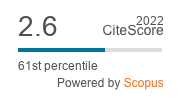Rusty Hungary: New Insights in Brownfield Research
DOI:
https://doi.org/10.1515/esrp-2017-0001Keywords:
brownfield regeneration, Hungary, real extent, second generation brownfieldsAbstract
Spatial development and planning in Hungary bear the marks of the post-socialist transformation. This is also observed in the handling of brownfields which, in the wake of political changes, increased in large numbers. In recent years a lot has happened, but we still know far too little about these areas. The paper focuses on the assessment of the extent of brownfields, their properties and regeneration in Hungary. The survey was based on collection of existing and accessible data at national and regional level, complemented by two personal databases. The study extends beyond the spatial dimension of brownfield sites. The results also emphasize further contexts of brownfield management that are not easily perceptible.
Downloads
References
BARTA, Gy. (2002a), Gazdasági átalakulás Budapest barnaövezetében, Budapest: HAS Centre for Economic and Regional Studies.
Google Scholar
BARTA, Gy. (2002b), A magyar ipar területi folyamatai, 1945–2000, Budapest–Pécs: Dialóg Campus.
Google Scholar
BARTA, Gy. (ed.) (2004), A budapesti barnaövezet megújulási esélyei, Budapest: HAS Centre for Social Sciences.
Google Scholar
BARTA, Gy., BELUSZKY, P., CZIRFUSZ, M., GYŐRI, R., KUKELY, Gy. (2006), ‘Rehabilitating the Brownfield Zones of Budapest’, Discussion Papers, 51, Pécs: HAS Centre for Regional Studies, http://w3.dti.rkk.hu/kiadv/discussion/discussion51.pdf (5.05.2016).
Google Scholar
BERKI, M. (2014), ‘Az ipari területektől a barnamezőkig: A fordista termelés válsága és a dezindusztrializáció folyamata Nyugaton és Keleten’, [in:] BERKI, M. and HALÁSZ, L. (eds.), A társadalom terei, a tér társadalma: megújulás és fenntarthatóság a város- és térségfejlesztésben, Tanulmánykötet Szirmai Viktória születésnapjára, Budapest: Art Webber Studio Kft., pp. 245–263.
Google Scholar
CES (2004), Database of Hungarian Brownfield Sites, http://www.ktk-ces.hu/brownfield_database_start.html (12.02.2016).
Google Scholar
CSAPÓ, J. and PINTÉR, R. (2015), ‘Adalékok vidéki településeink barnamezős területeinek turisztikai funkcióváltása kapcsán’, Településföldrajzi Tanulmányok, 4 (1), pp. 5–16.
Google Scholar
DOBÁK, J. (2013), ‘A diósgyőri kohászat barnamezős területének fejlesztési lehetőségei’, Észak-magyarországi Stratégiai Füzetek, 10 (1), pp. 37–48.
Google Scholar
GYŐRI, R. (2006), Zöldmezős és barnamezős beruházások a magyar nagyvárosokban, Pécs: HAS Centre for Economic and Regional Studies.
Google Scholar
HEGYI-KÉRI, Á. (2014), ‘A barnamezők jelenlétének munkaerőpiaci hatása’, Gazdaság és Társadalom, 6 (3), pp. 60–71.
Google Scholar
HORVÁTH, G., SZABÓ, I., SZACSURI, G. (2002), A barnamezők kérdéskörének, jogi gazdasági és környezetvédelmi vizsgálata, különös tekintettel a Borsod megyei régióra, Budapest: EMLA Foundation, http://alapitvany.emla.hu/sites/default/files/01-02barnamezö.pdf (21.03.2016).
Google Scholar
HŐNYI, P. (2006), ‘Barnaövek és városi területek rehabilitációja’, Kapos: ITK Kht., http://www.terport.hu/webfm_send/655 (14.12.2015)
Google Scholar
JANKÓ, F. and BERTALAN, L. (2009), ‘Egy sosemvolt iparváros ipari öröksége: barnamezők Sopronban’, Tér és Társadalom, 23 (4), pp. 103–116.
Google Scholar
KÁDÁR, K. and KOZMA, G. (2011), ‘Az egykori szovjet katonai területek funkcióváltása Debrecenben’, Tér és Társadalom, 25 (2), pp. 164–179.
Google Scholar
KISS, É. (2009), ‘Budapest ipari területei az utóbbi évtizedben’, Tér és Társadalom, 23 (2), pp. 69–85.
Google Scholar
KISS, É. (2010), Területi szerkezetváltás a magyar iparban 1989 után, Budapest–Pécs: Dialóg Campus, pp. 147–215.
Google Scholar
KUKELY, Gy., BARTA, Gy., BELUSZKY, P., GYŐRI, R. (2006), ‘Barnamezős területek rehabilitációja Budapesten’, Tér és Társadalom, 20 (1), pp. 57–71, http://geogr.elte.hu/TGF/TGF_Cikkek/kukely.pdf
Google Scholar
MOHOS, M. and GARDA, V. (2009), ‘Funkcióváltás Nagykanizsán a 21. században’, [in:] KOCSIS, Zs. (ed.), Közép- és nagyvárosok településföldrajza, Szombathely: Savaria University Press, pp. 282–291.
Google Scholar
MYRTTINEN, H. (2003), Base Conversion in Central and Eastern Euprope 1989–2003, Bonn: BICC, 30. https://www.bicc.de/uploads/tx_bicctools/paper30.pdf
Google Scholar
NAGY, Á. and TEŐKE, L. (2003), Az EU Strukturális Alapok keretében barnamezős rehabilitációra kiírandó pályázatok szakmai megalapozása, Budapest: VÀTI Kht.
Google Scholar
OROSZ, É. (2012), ‘A barnamező fogalmának változó értelmezése’, Tér és Társadalom, 26 (2), pp. 73–87.
Google Scholar
OROSZ, É. and PIRISI, G. (2014), ‘Weiße Flächen werden bunt. Stand und Probleme der Militärkonversion in Ungarn’, Europa Regional, 4 (12), pp. 183–199.
Google Scholar
PAPP, Gy., KŐRÖSI, V., GYÖNGYÖSSY, SZ., BÚZÁSNÉ JÓZSA, V., DERNEI, B. (2006), ‘Barnamezős területek az Észak-magyarországi régióban. Regiszter’, Észak-magyarországi tényképek, 1 (2), pp. 5–175.
Google Scholar
RONCZ, J. and TÓTHNÉ SZITA, K. (2012), ‘A barnamezők revitalizációjának tervezése életciklus elemzés segítségével’, Eco-Matrix, 1–2, pp. 13–36, http://www.academia.edu/12283867/A_barnamezők_revitalizációjának_tervezése_életciklus_elemzés_segítségével (7.06.2016)
Google Scholar
TFP (2014), ‘Barnamezős területek fejlesztése tematikus fejlesztési program’, http://budapest.hu/Documents/TFP/BarnamezősterületekfejlesztéseTematikusFejlesztésiProgram.pdf
Google Scholar
VARJÚ, V. (2008), ‘Barnamezős revitalizáció kultúrával’, [in:] PAP, N. (ed.), Kultúra – Területfejlesztés. Pécs – Európa Kulturális Fővárosa 2010-ben, Geographia Pannonica Nova 2, Pécs: Imedias Publisher, pp. 201–212.
Google Scholar
Downloads
Published
How to Cite
Issue
Section
License

This work is licensed under a Creative Commons Attribution-NonCommercial-NoDerivatives 4.0 International License.














